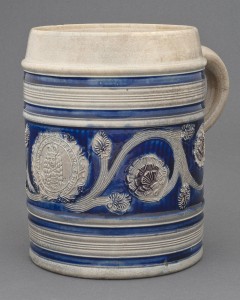In European as well as America, drinking vessels sometimes bore designs or inscriptions indicating support for the government. English ceramics as well as types made by other countries for English and her colonial markets, are particularly rich in such ornament.
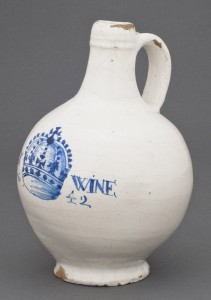 Jug or bottle commemorating King Charles I (r. 1625–49)
Jug or bottle commemorating King Charles I (r. 1625–49)
Probably Southwark, London, England; dated 1642
Earthenware (delftware)
Inscribed “WHiT [crown] WiNE / 1642”
Bequest of Henry Francis du Pont 1960.759
Intended for serving white wine at the table, this bottle dated 1642 bears a crown, indicating support for the British monarchy. Most crown bottles are dated 1649 to 1660, however. Made during the Reformation that followed Charles’s execution, they indicate anti-government sympathies. Many years later, in 1789, Queen Charlotte would write of seeing a similar vessel while breakfasting at the home of a friend:
At breakfast we Eat off the Old Family Pewter and used Silver Knives, Forks and Spoons which have been time immemorial in the Family and have always been kept at this place. The Decanters are of the year 1646 the name of the Wines burnt in the Earthenware…
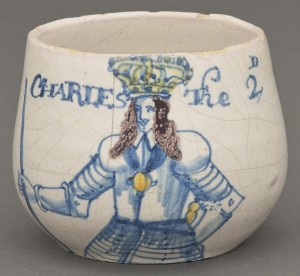 Caudle cup commemorating King Charles II (r. 1660–85)
Caudle cup commemorating King Charles II (r. 1660–85)
Probably Southwark, London, England; 1660–85
Earthenware (delftware)
Inscribed “CHARLES The 2D”
Bequest of Henry Francis du Pont 1954.536
On this cup, Charles II is portrayed in outdated armor, symbolic of his military power. Vessels of this type are called caudle cups, referring to a medicinal 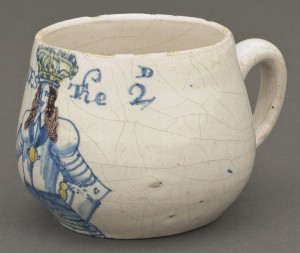 drink known from medieval times onward. In Englishman John Woodall’s Surgions Mate (1617), the author tells us that “A comfortable caudell [is] made with some wine, spices, sugar, and the yolke of an egge.” By the mid-1600s, caudle was also taken as a social beverage.
drink known from medieval times onward. In Englishman John Woodall’s Surgions Mate (1617), the author tells us that “A comfortable caudell [is] made with some wine, spices, sugar, and the yolke of an egge.” By the mid-1600s, caudle was also taken as a social beverage.
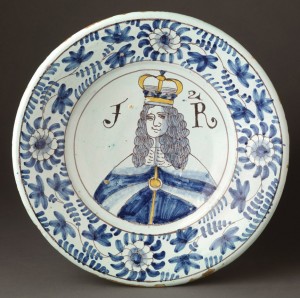 Dish portraying King James II (r. 1685–88)
Dish portraying King James II (r. 1685–88)
Brislington (nearBristol), England; 1685–88
Earthenware (delftware)
Gift of Henry Francis du Pont 1952.64
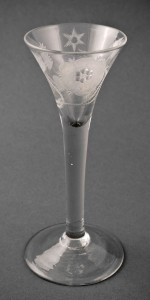 Wineglass commemorating the Jacobite cause
Wineglass commemorating the Jacobite cause
England; 1735–55
Glass (lead)
Inscribed “Fiat”
Promised gift of John A. and Judith C. Herdeg
The Glorious Revolution cut short the reign of Catholic James II (portrayed on the delftware dish) in favor of Protestant William and Mary, James’s daughter. Thus began the important and long-lived Jacobite political movement protesting the removal of Stuarts from the royal line. Jacobite toasts and drinking vessels were plentiful. On the glass shown here, the three roses represent James II and his sons, Charles Edward Stewart (Bonnie Prince Charlie) and Henry Benedict Stuart. The word Fiat, Latin for “Let it Be,” is associated with a prayer for the Stuarts’ return to the monarchy.
Mug commemorating King William III (r. 1689–1702)
Germany; 1689–1702
Stoneware
Inscribed “WILHELMVS . III. D. G. MAG. BRIT. FRANC. ET. HIB. REX” (William III. by the Grace of God, King of Great Britain, France, and Ireland)
Gift of Mrs. Mary H. Messinger 1993.121
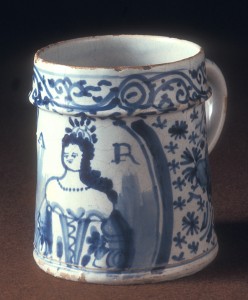
Mug commemorating Queen Anne (r. 1702–14)
Probably London, England; 1702–20
Earthenware (delftware)
Inscribed “AR”
Gift of Henry Francis du Pont 1954.98
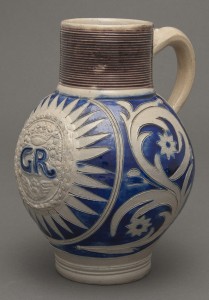 Jug commemorating King George I (r. 1714–27) or II (r. 1727–60)
Jug commemorating King George I (r. 1714–27) or II (r. 1727–60)
Germany; 1714–60
Stoneware
Inscribed “GR”
Gift of Mr. and Mrs. Dwight P. Lanmon 1992.124
These three vessels were appropriate for serving wine, beer, and concoctions like punch. The William III portrait mug and George I or II jug, initialed for the Latin Georgius Rex, are sturdy salt-glazed stoneware of the type made for several centuries in the Westerwald region of what is now Germany. The mug and jug were produced for the British and colonial markets, and fragments of related wares have been excavated at American sites. The delftware Queen Anne portrait mug (with “AR” for Anna Regina) is a rare survival.
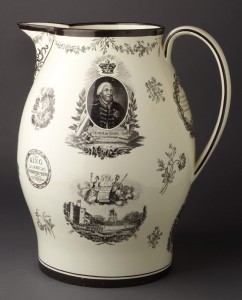 Jug commemorating King George III (r. 1760–1820)
Jug commemorating King George III (r. 1760–1820)
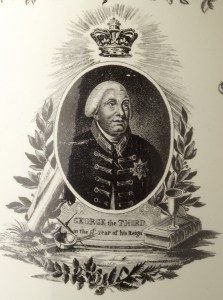 Thomas Dixon
Thomas Dixon
Herculaneum Pottery
Liverpool, England; about 1810
Earthenware (creamware)
Gift of S. Robert Teitelman, Roy T. Lefkoe, and Sydney Ann Lefkoe in memory of S. Robert Teitelman 2009.23.18
This monumental jug was created in honor of the 50-year jubilee of George III in 1809 and bears the king’s portrait, the royal coat of arms, and celebratory remarks and symbols. Under the handle is the rhyme,
Gentlemen, I you implore,
To stop awhile, for one jug more
To Toast an Health with loyalty,
Our KING, our FRIENDS, and COUNTRY.
The side features a portrait of Lord Viscount Wellington and a maritime battle scene honoring the future duke’s 1809 victories in Portugal. Presumably so soon after the American Revolution, such an object would have appealed exclusively to the English market.
Related Themes:

